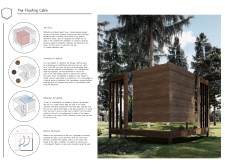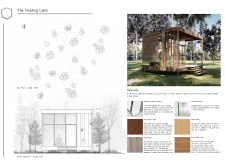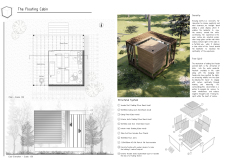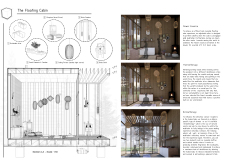5 key facts about this project
The Floating Cabin is an architectural project designed to create a retreat that fosters mindfulness and connection with nature. Nestled in a natural landscape, the cabin emphasizes sustainability through careful material selection and innovative design features. By providing a serene environment for meditation and introspection, this project aims to enhance the experience of living harmoniously within the wilderness.
The Floating Cabin demonstrates a thoughtful approach to spatial organization, featuring an open-plan layout that connects various functional areas. The use of large glass panels invites natural light into the interior, creating a fluid transition between the indoor and outdoor environments. The strategic placement of windows not only provides panoramic views but also allows for effective natural ventilation. This design enables occupants to engage with the natural surroundings, thus enhancing their experience of the space.
Innovative Material Selection and Sustainability
One of the unique aspects of The Floating Cabin is its deliberate choice of materials designed to promote both durability and ecological responsibility. Notable materials used in the project include reflective metal cladding, laminated glass, hard beech wood, silver beech wood for roof cladding, cedar wood for interior finishes, and kauri wood for the flooring. This combination not only offers aesthetic appeal but also aligns with sustainability goals through the use of local materials where possible.
A distinctive feature of the design is its rainwater harvesting system. This initiative collects rainwater from the roof and stores it in an underground tank, allowing for practical water use throughout the year. The incorporation of outdoor elements like bird feeders enhances interactions with wildlife, promoting a sense of tranquility among occupants.
Design Elements and Functional Spaces
The functional areas within The Floating Cabin are meticulously designed to support its primary purpose as a meditative retreat. The principle spaces include areas for meditation, preparation, and relaxation, each contributing to the overall experience of mindfulness. The interior finishes employ cedar wood, providing a warm aesthetic and pleasant aroma that adds to the sensory experience.
Noteworthy is the inclusion of architectural details like a fireplace and bird baths, designed to create focal points that improve the quality of engagement with the surroundings. These elements not only serve practical needs but also reinforce the themes of connecting with nature and promoting stillness.
For those interested in a more in-depth look at The Floating Cabin, reviewing the architectural plans, sections, designs, and ideas will provide a comprehensive understanding of this project’s innovative approach to architecture and design. Engage with the materials and functionalities that define this retreat for an enriching exploration of its features.





















































